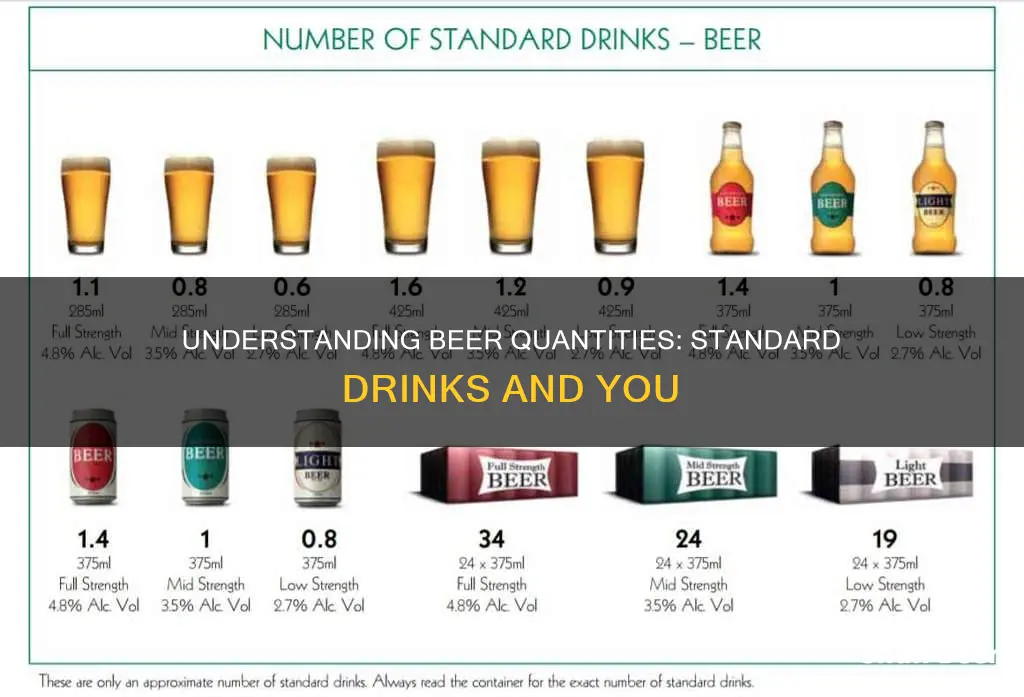
In the United States, a standard alcoholic drink is defined as any beverage containing 0.6 fluid ounces or 14 grams of pure alcohol. This is equivalent to 12 fluid ounces of regular beer, which is usually about 5% alcohol. However, it's important to note that different types of beer, such as craft beers, may contain higher alcohol percentages, ranging from 8% to 10% or more. Therefore, the amount of beer considered as one standard drink can vary depending on the specific type and alcohol content.
What You'll Learn

A standard drink is 12 fl oz of beer
In the United States, a standard drink is defined as any beverage containing 0.6 fluid ounces or 14 grams of pure alcohol. This is roughly equivalent to 12 fluid ounces of regular beer, typically containing about 5% alcohol.
It's important to note that the amount of liquid in your glass, can, or bottle may not accurately represent the amount of alcohol it contains. Different types of beer can have varying alcohol content. For example, while regular beer usually contains about 5% alcohol, some light beers may have about 4.2%. This means that a standard drink of light beer would be a larger volume than a standard drink of regular beer.
Additionally, the standard drink definition may not align with customary serving sizes. A single-serving drink may sometimes be equivalent to two or more standard drinks, depending on the container size. For instance, a 16-ounce pint of domestic beer, which is a common serving size, would be considered one and a third standard drinks.
The concept of a standard drink is essential for understanding and following health guidelines. It allows individuals to make informed decisions about their alcohol consumption and helps them track their drinks more effectively. By knowing that a standard drink of beer is typically 12 fluid ounces, individuals can better monitor their intake and make healthier choices.
In summary, a standard drink, as defined by the United States government, contains approximately 12 fluid ounces of regular beer. However, it is crucial to be mindful of variations in alcohol content and serving sizes when consuming alcoholic beverages. Understanding what constitutes a standard drink empowers individuals to make more informed and health-conscious choices.
Don't Drink Beer Podcast: Why You Should Listen Soberly
You may want to see also

Beer is typically 5% alcohol
Beer typically contains 5% alcohol, and in the United States, a "standard drink" is defined as a beverage containing 0.6 fluid ounces or 14 grams of pure alcohol. This means that a standard drink of beer is 12 fluid ounces, as this quantity contains approximately 0.6 ounces of pure alcohol.
It's important to note that the amount of liquid in a glass, can, or bottle may not always correspond to the amount of alcohol it contains. Different beers can have varying alcohol percentages, and craft beers, for example, may contain 8% to 10% alcohol or even more. Therefore, the number of standard drinks in a single serving of beer can vary depending on the type and brand.
When it comes to health guidelines, knowing how much alcohol is in your drink is crucial. In the United States, the U.S. Dietary Guidelines for Americans define moderate drinking as one drink per day for women and two drinks per day for men, among legal drinking-aged adults. Excessive drinking includes binge drinking, heavy drinking, any drinking by pregnant women, and any alcohol consumption by individuals under the age of 21.
Binge drinking is a pattern of drinking that raises a person's blood alcohol concentration (BAC) to 0.08 grams per cent or higher. This typically translates to four or more drinks for women or five or more drinks for men, consumed within about two hours. Binge drinking is associated with a heightened risk of unintentional injuries, violence, chronic diseases, cancer, and alcohol dependence.
Heavy drinking is defined as consuming eight or more drinks per week for women or 15 or more drinks per week for men. Alcohol consumption during pregnancy can put the baby at risk for lifelong physical, educational, behavioural, and emotional problems. Additionally, youth who start drinking alcohol before the age of 15 are four times more likely to develop alcohol dependence compared to those who wait until they are 21.
How Long Does Opened Beer Stay Fresh?
You may want to see also

One standard drink = 0.6 fl oz of pure alcohol
In the United States, a standard drink is defined as any beverage containing 0.6 fl oz of pure alcohol. This is equivalent to about 14 grams of alcohol. It's important to note that the amount of liquid in your glass, can, or bottle does not necessarily reflect the amount of alcohol in your drink. Different types of beer, wine, or malt liquor can have varying alcohol content. For instance, regular beer typically has an alcohol content of 5%, while some light beers contain about 4.2%.
To put it into perspective, a standard drink of beer is 12 fl oz of regular beer, which is usually about 5% alcohol. This means that a standard drink in terms of beer is a 12-ounce can or bottle of most domestic beers, as they typically have an alcohol content of 5%. On the other hand, craft beers may have a higher alcohol content, ranging from 8% to 10% or more, so the same 12-ounce serving would contain more than a standard drink.
When it comes to wine, 5 fl oz of wine is considered a standard drink, as it typically contains about 12% alcohol. For distilled spirits or liquor, one standard drink is equivalent to 1.5 fl oz (a single jigger) of 80-proof liquor, which includes brandy, gin, rum, tequila, vodka, and whiskey. 80-proof liquor has an alcohol content of 40%.
It's worth noting that the standard drink measurements are based on the amount of pure alcohol and may not align with customary serving sizes. These measurements are helpful for following health guidelines and understanding alcohol consumption. However, the way alcohol affects the body can vary from person to person, and factors such as gender, mood, food intake, speed of consumption, tolerance, and physical condition can influence the impact of alcohol on an individual.
Beer Consumption: Safe Daily Limits and Health Considerations
You may want to see also

Alcohol content varies by beer type
Craft beers can vary in ABV but usually range from 6% to 10%. Stronger styles, such as double IPAs and imperial stouts, can reach ABVs as high as 15% or more. For example, Brewmeister Snake Venom, the world's strongest beer produced in Scotland, has 67.5% ABV.
The ABV of a beer stems from fermentation. During this process, yeast converts the sugars in malted grains into alcohol and carbon dioxide. The longer the fermentation, the higher the ABV.
The amount of alcohol in beer varies considerably between countries. In the United States, beer typically contains 4% to 6% ABV, but many higher ABV options exist. In the United Kingdom, beer often has an ABV of 3% to 4%, while stronger ales can feature up to 9% ABV. German beers usually fall between 4.7% and 5.4%, but some can contain up to 16% ABV. In Asian countries, beer tends to be much lighter, with Chinese beer at around 3% ABV. In some African countries, traditional beers can be as low as 1% ABV.
Understanding the alcohol content of beer is important for responsible consumption and preventing the negative consequences of heavy drinking. The ABV listed on a beer label helps consumers estimate the potential impact of a specific beer on their body. It is also essential for following health guidelines and legal serving size regulations.
Root Beer and Wisdom Teeth: What's Safe to Drink?
You may want to see also

Alcohol affects individuals differently
In the United States, a "standard drink" is defined as any beverage containing 0.6 fluid ounces or 14 grams of pure alcohol. This is roughly equivalent to 12 fluid ounces of regular beer, which is usually about 5% alcohol. However, it's important to note that different types of beer can have varying alcohol content, and the standard drink definition may not reflect customary serving sizes.
Now, onto the main question: why does alcohol affect individuals differently? Well, there are several factors at play, and it's a combination of these factors that creates a unique experience for each person. Here are some of the key reasons:
Body Weight and Body Fat Content
The impact of body weight and body fat content is crucial when it comes to alcohol absorption. Generally, a smaller person will be more sensitive to the effects of alcohol. This is because a bigger person will have a slower absorption rate, as the alcohol becomes diluted over a larger volume.
Food Intake
The amount of food in your system can also influence how alcohol affects you. Food, especially high-fat, high-protein, and fatty foods, slows down the absorption of alcohol, giving your liver more time to process it. On the other hand, drinking on an empty stomach allows alcohol to reach the liver more quickly, potentially overwhelming it.
Metabolism
Metabolism plays a significant role in breaking down alcohol. People with higher metabolisms can process alcohol more efficiently, resulting in fewer negative effects. The liver, which is responsible for metabolizing alcohol, has a finite amount of glutathione, an antioxidant crucial for this process.
Gender
Gender also plays a role in how alcohol affects individuals. Women tend to experience the effects of alcohol more strongly and for longer periods, even when accounting for body weight and height. This is due to various factors, including lower body water content, lower levels of the enzyme dehydrogenase, and hormonal fluctuations.
Age
Age can also influence alcohol absorption. As people age, they tend to lose muscle and gain fat, which can make it more difficult for their bodies to absorb alcohol. Older individuals may have higher levels of alcohol in their system and may become intoxicated more quickly, even if they report feeling fewer effects.
Genetics and Ethnicity
Genetics and ethnicity can also contribute to the unique effects of alcohol on an individual. Certain ethnicities have slower metabolic rates due to lower enzyme levels, leading to higher feelings of intoxication. Additionally, a family history of alcohol use disorders can increase the risk of alcohol-related issues.
Tolerance
Tolerance refers to the body's ability to adapt to alcohol over time. Some people may develop a high tolerance, requiring more alcohol to feel its effects. However, tolerance does not change the blood alcohol concentration (BAC) and can be a sign of a developing problem with alcohol.
Medication and Drug Use
Mixing alcohol with medications or other drugs can have serious consequences. It can increase the effects of both substances and lead to dangerous interactions. Stimulants, for example, can make a person feel less drunk, while depressants can have the opposite effect.
Carbonation and Mixers
Carbonated alcoholic drinks and certain mixers can increase the rate of alcohol absorption. The pressure in the stomach and small intestine forces the alcohol to be absorbed more quickly into the bloodstream. Sugary mixers and soft drinks can have a similar effect.
Mental and Physical Health
An individual's mental and physical health can also impact how alcohol affects them. Being stressed, exhausted, depressed, or anxious can enhance the effects of alcohol. Additionally, being sick or fatigued can lead to dehydration, which increases BAC.
In summary, while the effects of alcohol can be fairly consistent across individuals, there are numerous factors that can cause unique variations. Understanding these factors can help people make informed decisions about their drinking habits and maintain a healthy relationship with alcohol.
Is Mixing Aleve and Alcohol Ever Safe?
You may want to see also
Frequently asked questions
A standard drink is 12 ounces of beer.
A standard drink contains 0.6 fluid ounces or 14 grams of pure alcohol.
A typical bottle of wine is 750ml and contains approximately 5 standard drinks.
A shot of 80-proof distilled spirits contains 1.5 ounces of alcohol, which is equivalent to one standard drink.







